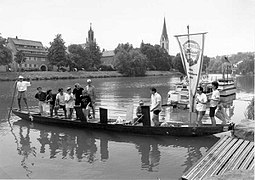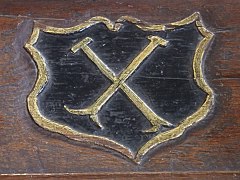Poke rod
A poke rod (also Stakholz , Stake , Stachel or in the Spreewald Rudel ) is a rod made of wood with a length of typically four to six meters , with the help of which, in particular, smaller watercraft such as boats and barges in waters with low water levels by pushing off the bottom of the Water can be moved. The corresponding activities will Punting (also in Low German staaken ), spines (Swiss German) or poke called.
The ship's command or the ferryman stands upright in the watercraft when pegging . This method is used for. B. drive at river , on slow-flowing waters such as waterways in wetlands or on other shallow waters. As the Torfkähne on Steinhude with no wind punted .
After their fixation in the ground, stakes can also be used to fix a boat on a body of water. An ordinary boat hook can also serve as a stake.
This drive technology used to be widespread on narrow and shallow waters in England : punting was originally used there to transport people and goods on flat barges, today such barges are used for recreational activities and as a tourist attraction.
Punch rods are and were an item of equipment in pearl fishing . When diving in deeper water, the pearl fishermen hold on to the pegs until they reach the bottom of the sea.
In the tenth tablet of the Gilgameš epic the picks were needed for a safe crossing over the “ waters of death ”.
In Western art, at least since the Renaissance, the ferryman Charon , who translates the dead into the realm of Hades , has been depicted with a flat boat and a pole.
In the stalls of the St. Nicolai Church in Mölln there are two crossed stakes as a symbol of the Stecknitz driver guild .
photos
literature
- Robert T. Rivington: Punts and Punting. Oxford 1982, ISBN 0-9508045-0-9 .
- Stefan M. Maul: The Gilgamesh Epic. Beck, Munich 2006, ISBN 3-406-52870-8 .



